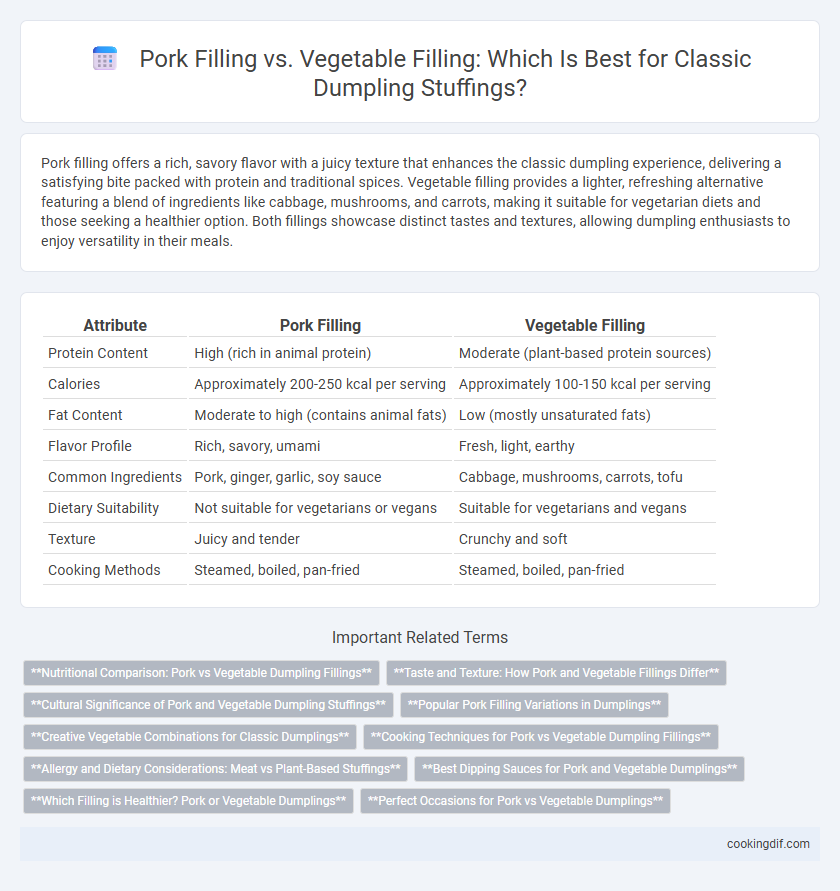Pork filling offers a rich, savory flavor with a juicy texture that enhances the classic dumpling experience, delivering a satisfying bite packed with protein and traditional spices. Vegetable filling provides a lighter, refreshing alternative featuring a blend of ingredients like cabbage, mushrooms, and carrots, making it suitable for vegetarian diets and those seeking a healthier option. Both fillings showcase distinct tastes and textures, allowing dumpling enthusiasts to enjoy versatility in their meals.
Table of Comparison
| Attribute | Pork Filling | Vegetable Filling |
|---|---|---|
| Protein Content | High (rich in animal protein) | Moderate (plant-based protein sources) |
| Calories | Approximately 200-250 kcal per serving | Approximately 100-150 kcal per serving |
| Fat Content | Moderate to high (contains animal fats) | Low (mostly unsaturated fats) |
| Flavor Profile | Rich, savory, umami | Fresh, light, earthy |
| Common Ingredients | Pork, ginger, garlic, soy sauce | Cabbage, mushrooms, carrots, tofu |
| Dietary Suitability | Not suitable for vegetarians or vegans | Suitable for vegetarians and vegans |
| Texture | Juicy and tender | Crunchy and soft |
| Cooking Methods | Steamed, boiled, pan-fried | Steamed, boiled, pan-fried |
Nutritional Comparison: Pork vs Vegetable Dumpling Fillings
Pork dumpling fillings typically provide higher protein levels and essential B vitamins, including B12, which are crucial for muscle health and energy metabolism. Vegetable fillings, rich in fiber, vitamins A and C, and antioxidants, support digestive health and boost the immune system while offering lower fat and calorie content. Choosing between pork and vegetable fillings affects overall nutrient intake, with pork delivering more protein and vegetables enhancing vitamin and fiber consumption.
Taste and Texture: How Pork and Vegetable Fillings Differ
Pork filling in dumplings offers a rich, savory taste with a juicy and tender texture due to its higher fat content, providing a satisfying mouthfeel. Vegetable fillings, often made with ingredients like cabbage, mushrooms, and carrots, deliver a lighter, fresher flavor with a slightly crunchy texture that contrasts the softness of the wrapper. The umami depth in pork contrasts with the crisp, earthy notes of vegetables, influencing preference based on desired richness and bite.
Cultural Significance of Pork and Vegetable Dumpling Stuffings
Pork filling in dumplings holds deep cultural significance in many Asian cuisines, symbolizing prosperity and family unity during traditional celebrations like Lunar New Year. Vegetable fillings, often featuring cabbage, mushrooms, and tofu, reflect dietary adaptation and spiritual values such as health and harmony, especially within Buddhist communities. Both fillings illustrate regional culinary diversity and highlight the historical evolution of dumpling recipes shaped by agricultural practices and cultural beliefs.
Popular Pork Filling Variations in Dumplings
Popular pork filling variations in dumplings often include a combination of ground pork, garlic, ginger, scallions, soy sauce, and sesame oil, creating a savory and aromatic profile. Variants such as pork and cabbage, pork and chive, or pork with shrimp add unique textures and flavors while maintaining the traditional umami essence. These combinations highlight the versatility of pork as a filling, offering rich taste contrasts compared to lighter vegetable fillings.
Creative Vegetable Combinations for Classic Dumplings
Creative vegetable combinations for classic dumplings include blends like shiitake mushrooms with napa cabbage, garlic chives with tofu, and grated carrots paired with ginger and scallions. These mixtures offer vibrant flavors and textures that rival traditional pork fillings while catering to vegetarian preferences. Incorporating umami-rich ingredients such as fermented black beans or miso paste enhances depth and complexity in vegetable dumplings.
Cooking Techniques for Pork vs Vegetable Dumpling Fillings
Pork dumpling fillings require thorough cooking to ensure safety, often achieved by steaming, boiling, or pan-frying until the meat reaches an internal temperature of 160degF (71degC). Vegetable fillings, featuring ingredients like cabbage, mushrooms, and carrots, can be pre-cooked through sauteing or blanching to reduce moisture and enhance flavor before wrapping. Adjusting cooking time and methods is essential for pork and vegetable dumplings to maintain optimal texture and prevent sogginess or undercooking.
Allergy and Dietary Considerations: Meat vs Plant-Based Stuffings
Pork filling in dumplings may pose allergy risks due to common meat allergens and is unsuitable for vegetarians or individuals following kosher or halal diets. Vegetable fillings offer a hypoallergenic alternative, catering to vegan, vegetarian, and lactose-intolerant consumers while providing essential fiber and nutrients. Choosing between meat and plant-based fillings significantly impacts dietary restrictions, allergen exposure, and nutritional preferences in classic dumpling recipes.
Best Dipping Sauces for Pork and Vegetable Dumplings
Pork dumplings pair exceptionally well with dipping sauces featuring soy sauce, garlic, and a splash of rice vinegar to complement their rich, savory flavor. Vegetable dumplings are enhanced by lighter sauces incorporating sesame oil, ginger, and chili flakes, which highlight their fresh, earthy taste. Balancing acidity and spice in these sauces elevates the overall dumpling experience, making the choice of dipping sauce crucial for both pork and vegetable fillings.
Which Filling is Healthier? Pork or Vegetable Dumplings
Vegetable dumplings generally offer a healthier option due to lower calorie and fat content, along with higher fiber and essential vitamins from ingredients like cabbage, mushrooms, and carrots. Pork fillings, while rich in protein and iron, tend to have higher saturated fat and cholesterol levels, potentially impacting heart health when consumed frequently. Choosing vegetable dumplings supports a nutrient-dense diet, especially for those seeking weight management or cardiovascular benefits.
Perfect Occasions for Pork vs Vegetable Dumplings
Pork dumplings are ideal for festive gatherings and hearty meals, offering rich, savory flavors that complement celebrations like Lunar New Year or family reunions. Vegetable dumplings suit lighter occasions such as lunch breaks, vegetarian dinners, or health-conscious events where fresh ingredients and subtle tastes are preferred. Both options provide versatile choices, enhancing menus with protein-rich pork or nutrient-dense vegetables to cater to diverse dietary preferences and event atmospheres.
Pork filling vs Vegetable filling for classic stuffings Infographic

 cookingdif.com
cookingdif.com